I first interviewed George Byrne in 2020 during his solo exhibition, “Post Truth,” at domicile (n.) in East Hollywood. The article “Lensman as a Cultural Conservationist” was published at the height of the pandemic. We met on the back patio of the Hollywood gallery, under the shadow of the Scientology building, also known as “Big Blue.” Seated six feet apart, we both wore two masks despite being outdoors. It felt apropos to speak about Los Angeles, the subject and preoccupation of Byrne’s work, surrounded by a surreal embrace. The scene felt copied and pasted, taken straight from one of the artist’s urban scenes- a resounding stillness that resisted the traffic echoing beyond the fence and flora sprouting from the asphalt set against a masonry garden. Even the natural lighting was on cue, remaining suspended in equal parts sunlight and shadows cut at right angles.
Nearly five years later, we sat down again, but this time in front of our screens to discuss a new body of work titled “Synthetica.” The photographs will be exhibited at Show Gallery beginning June 13, 2024. This interview, however, was a unique experience conducted entirely through digital channels before Byrne’s solo exhibition “Synthetica” opened. My only impression of the work has been through a virtual viewing room. Our dialogue was exchanged through digital interfaces—text messages, voice memos, and emails. None of this conversation took place in person, but that’s what piqued our interest in this approach. The manner in which the interview was conducted was a reflects the innovative ethos inherent to the body of work in question.
After a decade of exhibiting photographs of Los Angeles, “Synthetica” can be seen as a love letter or thank-you note to the city of Angels. The photographic method is a testament to Byrne’s dedication and skill, as the images are captured on a Pentax 67 Medium Format camera. The origins of every image are 100% analog. The transformation or synthesis begins through meditative addition, subtraction, collage, and endless reevaluation. Byrne adheres to a meticulous methodology to maintain continuity as the images become more malleable and less static. The artist explains that after sifting through low-resolution scans, he selects which images he wants to set to work on. These “sketches” are then added to the original low-resolution scans. After discovering which sketches work best and through a series of internal rearranging, the frames are processed again by a high-powered drum scanner that yields the final large digital file.
“Post Truth,” is a story begins in the city’s center, specifically at the “Fitzroy Pool.” The artificial body of water signals for our ascension, instructed by the shallow ladder beneath the chlorine, the triangular metal handrails, and the yellow concrete steps leading up to the outdoor bleachers.
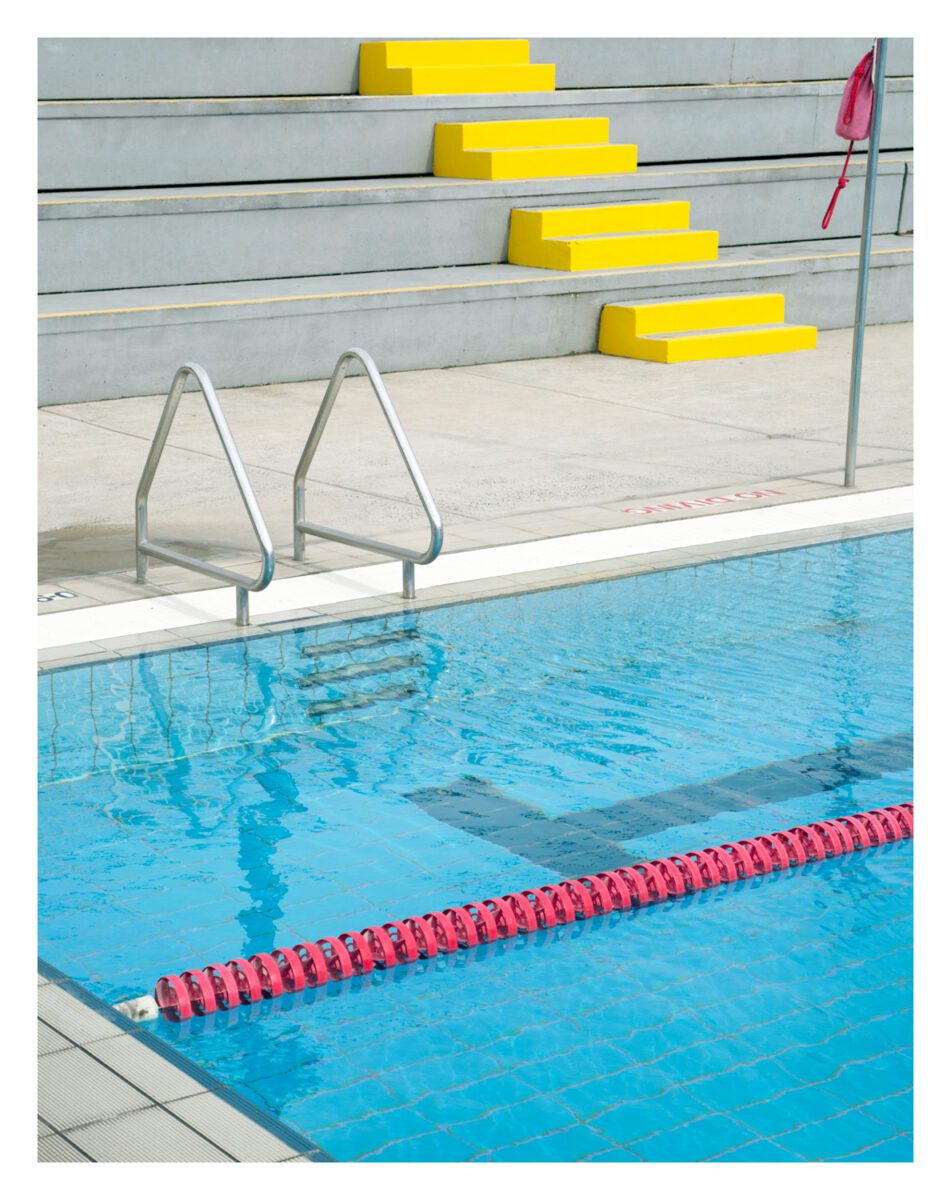
Archival Pigment Print
Photograph courtesy of George Byrne
From the series “Post Truth”
In “Synthetica,” we arrive at the water, the Pacific Ocean, after a journey through Route 66 and back to the coast. The shop’s facade in “Rego Sport Tuning” is just that- a portal through layers, sketches on film. The shop contains the fossils from previous work- art deco palettes, the primary colors of stop signs and parking lot barriers, an unseasonal moon, and the recurring ascending masonry found in “Cypress & Cloud,” the featured image of “Post Truth.” The assemblage of pieces from Byrne’s version of Los Angeles- a city that is drenched in a beautiful oddity and assumes layers of stucco, paint, and style. As if captured from a whirlwind, the elements and colors from past photographs hide in plain sight and reside at “Regot Sport Tuning.” Arriving at the moment of realization is the crescendo of a symphony that Byrne has been writing this entire time.
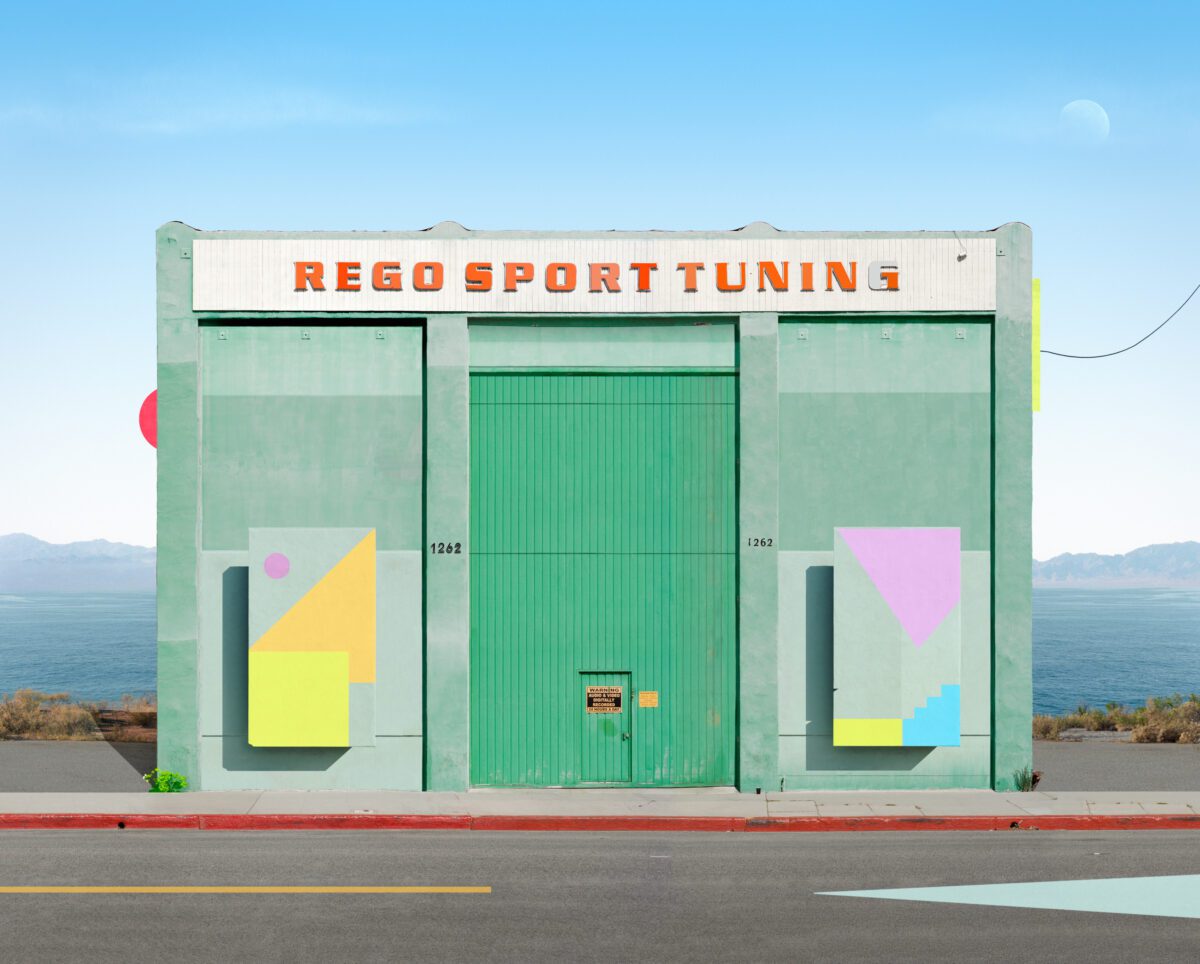
Archival Pigment Print
Photograph courtesy of George Byrne
From the series “Synthetica”
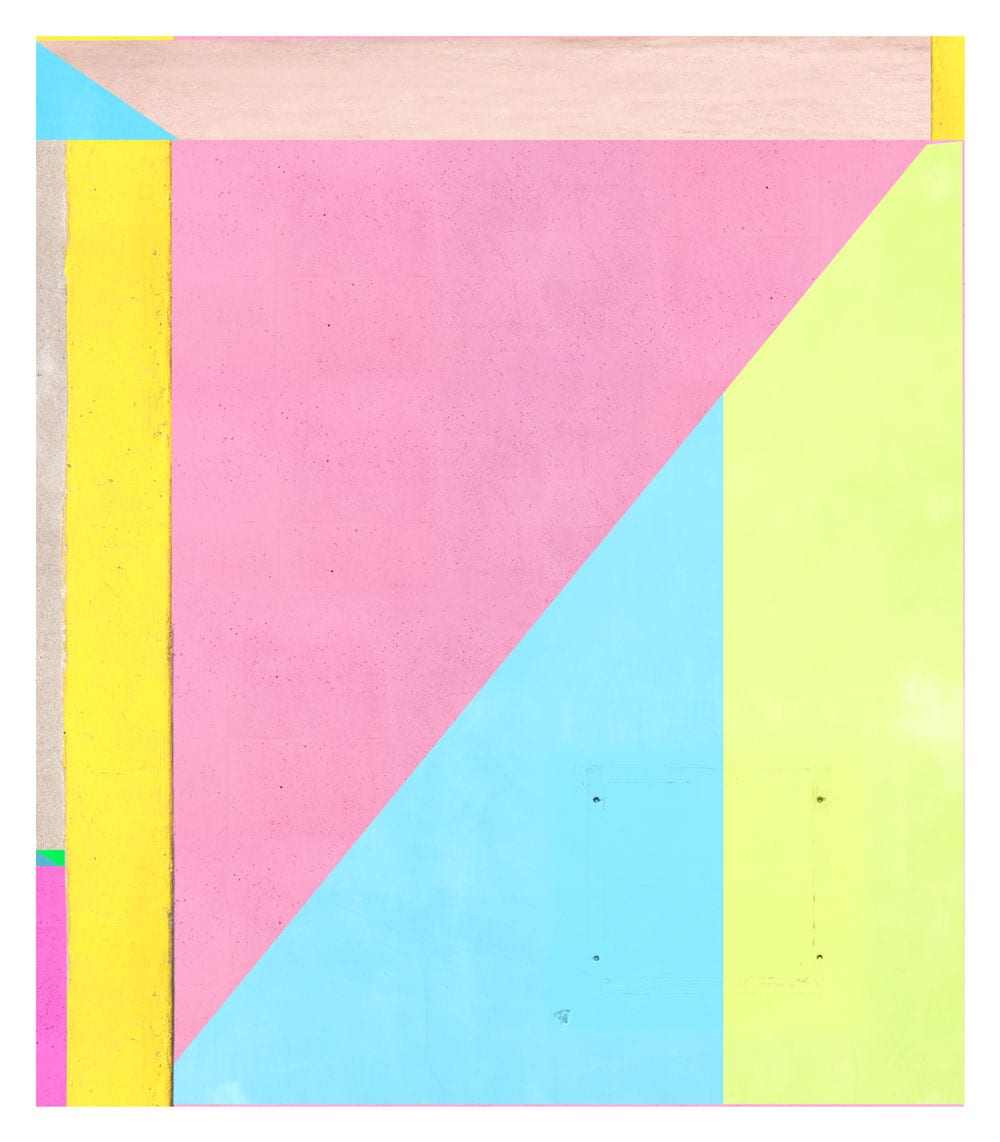
Archival Pigment Print
Artwork courtesy of George Byrne
From the series “Post Truth”
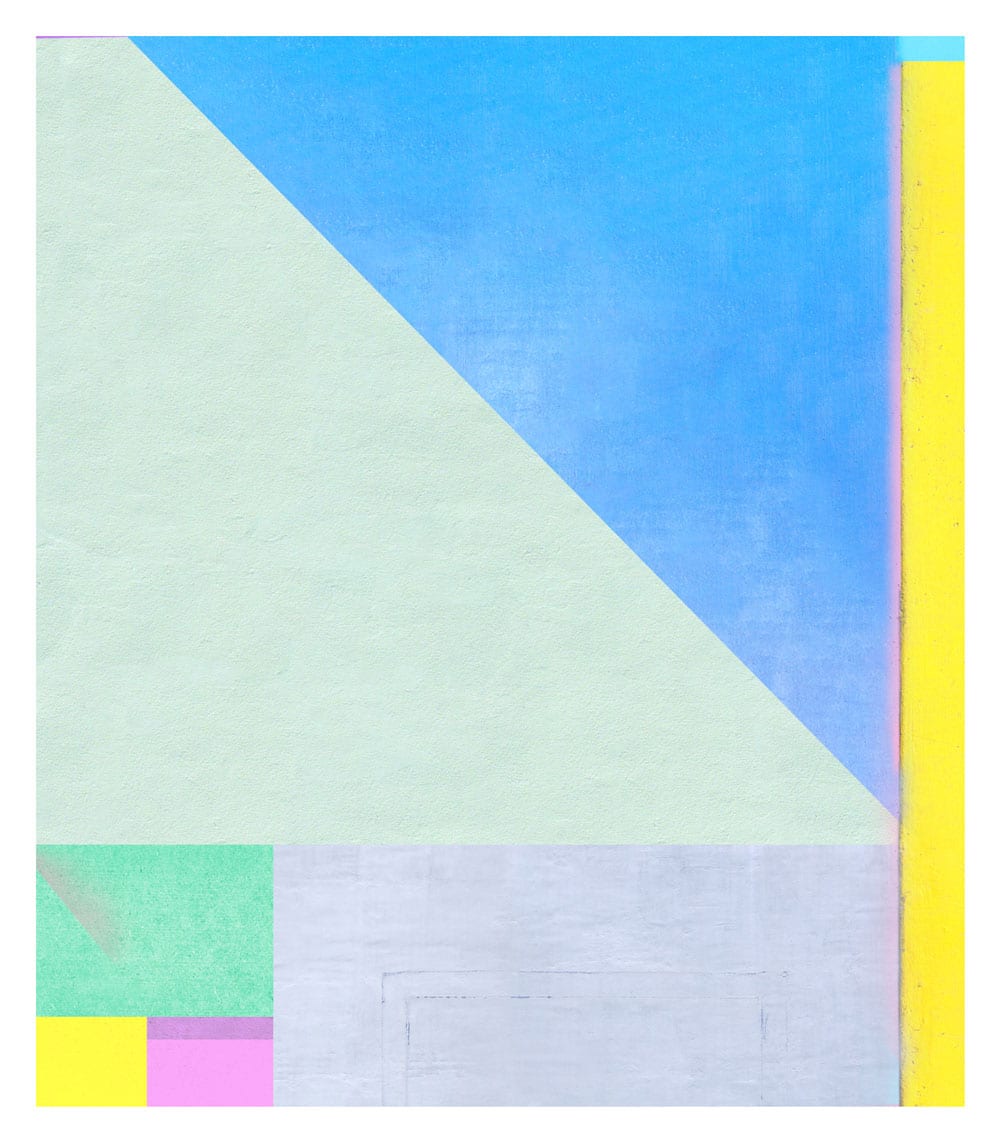
Archival Pigment Print
Artwork courtesy of George Byrne
From the series “Post Truth”
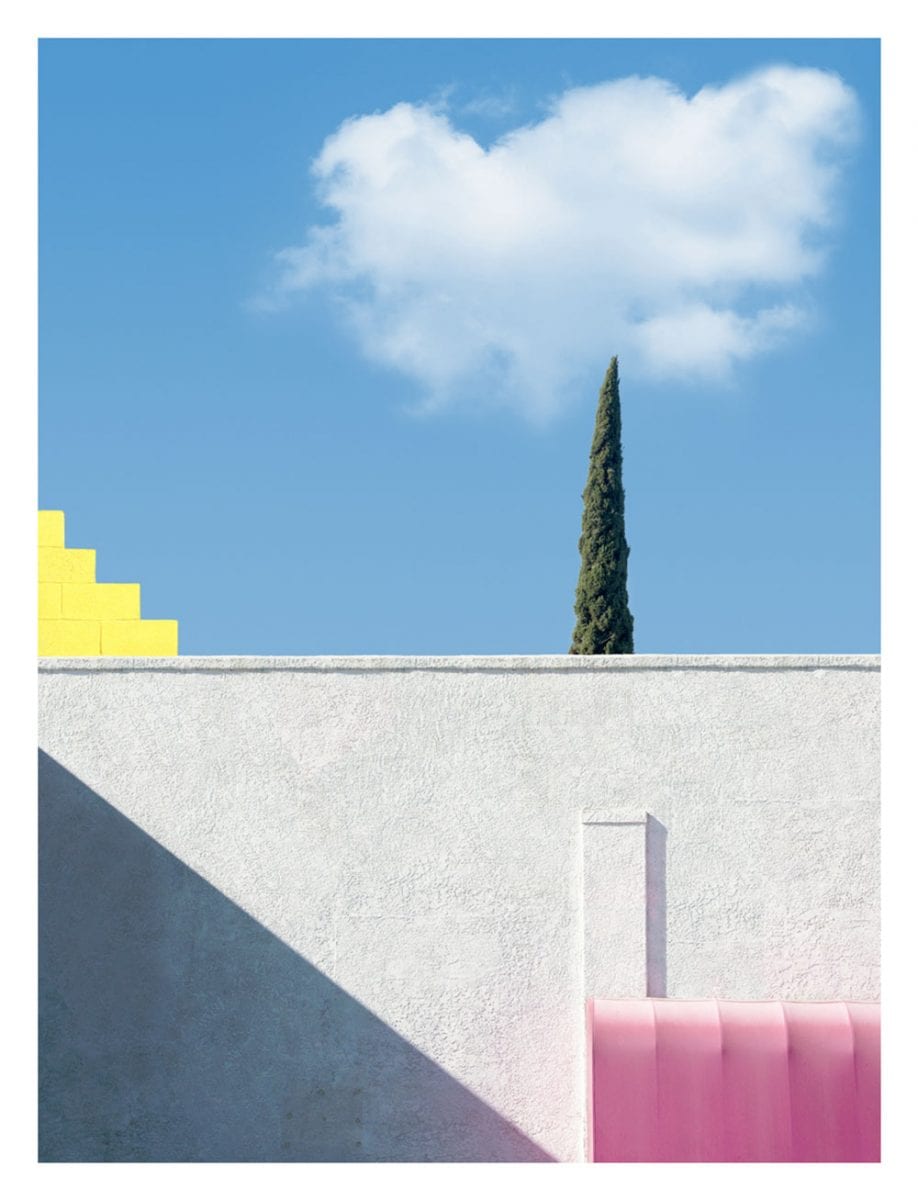
Archival Pigment Print
Image courtesy of George Byrne
From the series “Post Truth”
An ode to dissociation and synthesis, “Synthetica” is a conscious title that injects the presence of a person, the man behind the camera, into the alchemical process. Byrne could have easily called the show “Synthesis,” a passive process whereby change has already occurred, but “Synthetica” feels more active and faithful to the humanity of his style.
The work “Evolution” shows a carnival-style amusement suspended above a mountain range. Do you feel that after ten years, you have undergone an evolution of your own? How have you grown as a photographer in the last decade?
100% yes, and those pictures resonated with me for that reason. My career as a full-time exhibiting artist has been a thrilling ride. You have to remember my opportunity to do this came out of nowhere. In 2014, I was a broke musician working at a coffee shop, and a year later, I’m flying this plane. I know I’m pretty good at what I do, but I also got so lucky on so many levels in order to get that start the way I did.
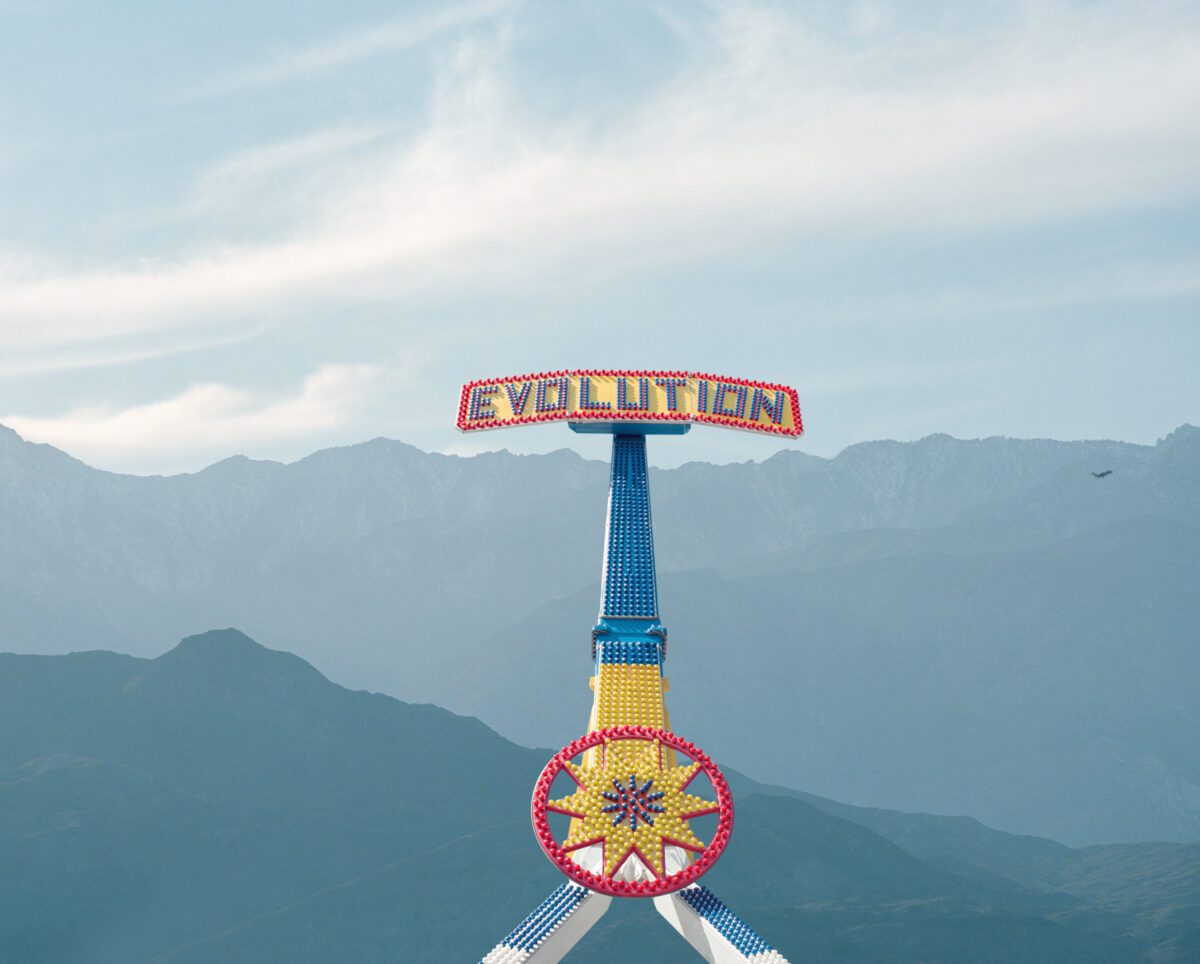

Archival Pigment Print
Photograph courtesy of George Byrne
From the series “Synthetica”
Let’s go back to 2014 when you worked at a coffee shop and played music. When you left Sydney for Los Angeles, what were your plans?
I left Sydney for the USA in September 2010. I had a one-way ticket with a few loose plans and some friends living and working in the music business in LA at that time. I had a three-year visa that I was granted through my music career back in Australia. I had no idea what was in store at all. I was planning on just having a go at everything to see what might stick. It was a very exciting time.
What parallels can you draw from music to photography?
There are a lot of parallels for me. While I feel like I’m using a different part of my brain, there is harmony/alchemy in both mediums. Both songwriting and image-making require structure, flow, and composition. I approached the photographic series I was working on in a similar way to how I would write records. 12-15 songs, 12-15 images. In both mediums, I would have a title track. I’d have the radio song, the sleeper, the ballad. Because I was coming from music, these things were natural. I would also complete images at a similar rate to how I’d complete songs. Some images I would create would almost feel like a visual chord to me, with different colors adding unique tonal effects.
Besides the tonal effects imbued in your photographs, there is a palpable curiosity surrounding mysticism. What tenents of Theosophy do you most align with? Which images do you think most reflect those principles?
My own education in Theosophical concepts came through reading about other artists I liked. I liked the principle of mixing Eastern and Western spiritual traditions, but more importantly, for me it was the idea of images or things transcending straight representation or a straight narrative…which is kind of what my work is about. I’m trying to evoke a sense of the mystical or spiritual in the everyday world around me. There are a few works in the show that I think reflect this idea. Take “Mural Wall, Venice,” this composition juxtaposes an old peeling mural backdrop of towering redwoods with the more mundane elements of urban life. There is complexity posing as simplicity. There are layers. The blending of natural and artificial elements speaks to the idea of a hidden reality behind the physical world. Also, “Fountain Ave.” and “Monolith Palm Springs.” These are all images that I think draw these ideas.


Archival Pigment Print
Photograph courtesy of George Byrne
From the series “Synthetica”
Photographs such as”Fountain Avenue,” “Desert Collage,” “Liquor Store Yucca Valley,” and “Rainbow Wall” each play with the duality of your interpretation of Theosophy. The concrete jungle and the natural world co-exist to create a sense of hyperreality so that the photograph resists being a straight urban scene or landscape. It is both and neither. You said this peeling back of layers “speaks to the idea of a hidden reality behind the physical world.” What have you learned in documenting this “hidden reality?”
I’ve learned that everything is open to interpretation;ultimately, nothing is as it seems. We are always viewing the world in a state of major transition, whether it’s a street corner or a mountain range. It’s just that we can’t see it, as humans are viewing it in the slowest of slow motions. These are very non-traditional photographic principles or philosophies, but that’s just how I approached photography from the start. It’s just a way to represent something…and the more malleable I made photography for the purposes of my work, the more challenging it became. Because, really, once you start manipulating your photos, you’re making a photo digital painting; there is no start or finish, and you enter the realm of infinite decision-making. You have to make boundaries for yourself and be clear about your aims. Hence, the jump into painting has been interesting.
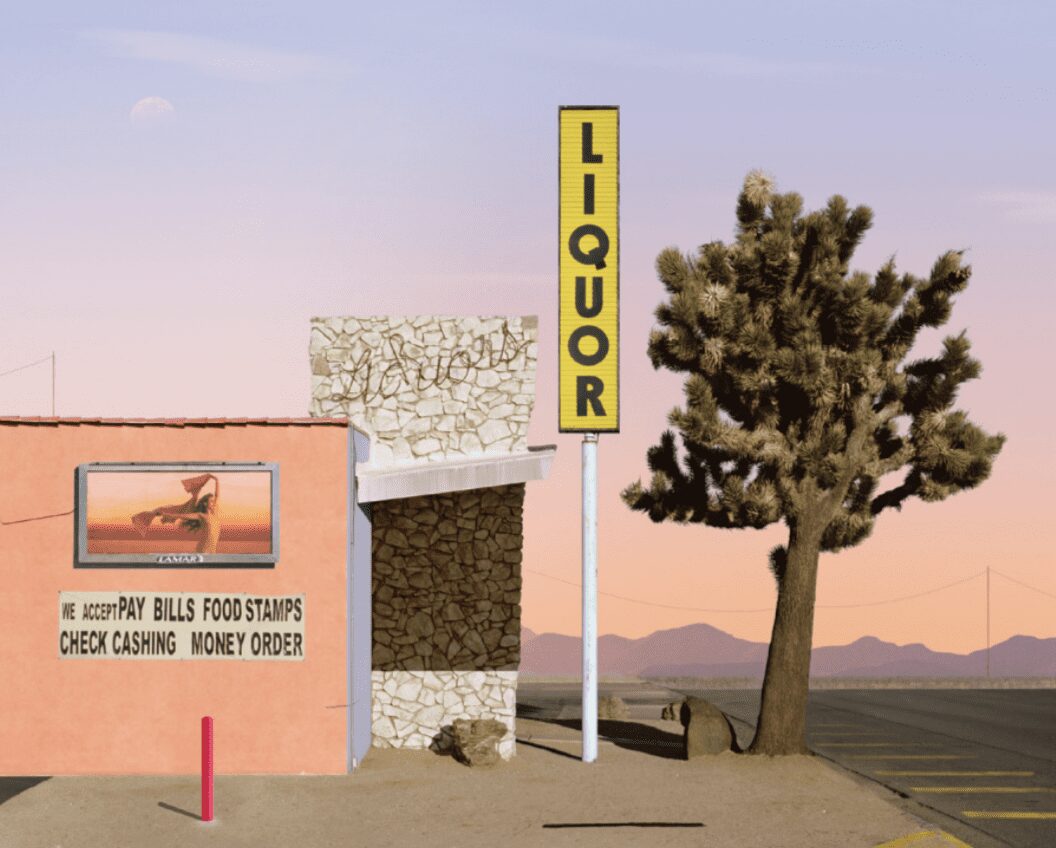

Archival Pigment Print
Photograph courtesy of George Byrne
From the series “Synthetica”
I instantly felt that many of your works have a painterly quality, so I wasn’t surprised to learn you are now exploring painting formally. The pastel and heavily saturated hues make the photographs feel hyper-real. What colors are you most connected to? What colors do you think work best in one frame?
I don’t have any formal training in color theory, so I just go off instinct. There are so many alchemic combinations and color relationships that it’s impossible for me to pinpoint. My work shot in LA does tend to have washed-out, pastel colors, but that’s just the nature of the city, given the 300 days of blazing sun.
“Synthetica,” derived from “synthetic,” translates to “of, relating to, or produced by chemical or biochemical synthesis. Mainly: produced artificially.” You cite the series’ origins beginning about five years ago, bringing us closer to the body of work “Post Truth,” Was this body of work informed by “Post Truth” in any way? If so, was there a particular image that acted as the catalyst?
Yes, this series was absolutely informed by my “Post Truth” series from 2019. I guess all my work is connected; it just evolves in line with whatever technical or theoretical direction I’ve taken in the time leading up to an exhibition. The “Sythnetica” series is basically further deconstructing some of the things I was doing in “Post Truth.” (i.e., more fabrication, coloring, collage…), basically pushing the imagery further away from reality but still using photographic chunks of the real stuff. They’re dreamscapes. I also included more work shot outside Los Angeles and California. “Biloxi Mississippi, 2024” was probably the catalyst image for the series.
What constitutes a “dreamscape?”
When I say “dreamscape,” I guess I mean in the same way a Gregory Crewdson or Andreas Gursky photo is a dreamscape…in that the locations/things depicted are often based on a true story but open to interpretation. Things are not always as they seem.
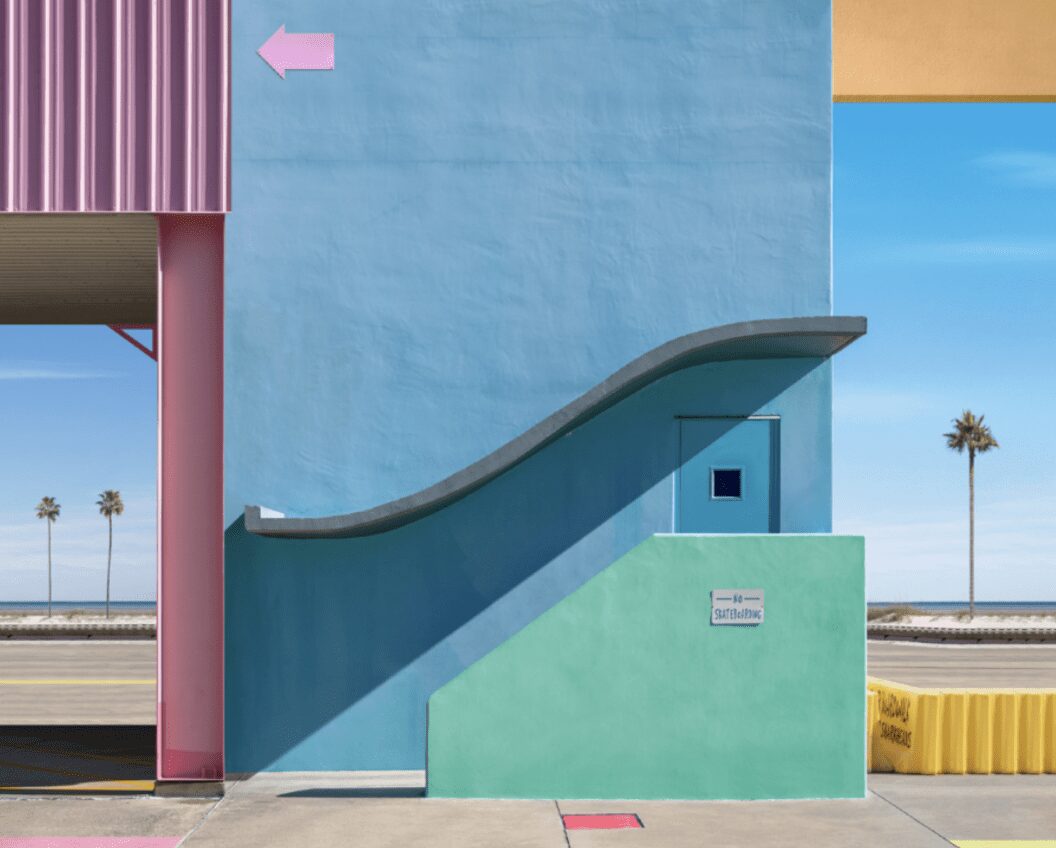

Archival Pigment Print
Photograph courtesy of George Byrne
From the series “Synthetica”
What are your thoughts on the term “synthetic photography?” Does the term align with your new direction?
I like the term “synthetic photography;” I think it’s very accurate. Strangely enough, I named my show “Synthetica” prior to the AI stuff happening. My work has evolved over the past ten years since I moved to LA, and it has really been towards non-real/hyperreal or synthetic photography. I was just doing it in an analog fashion.
In our exchange about the process that your images undergo, you allude to an “idea of layers and dissociation of synthesis, putting one’s work in the blender and bringing back a new canvas.” The generative nature you describe makes me think of AI, which is, by default, a composition where “things are not always as they seem.” There is a divided school of thinking among artists, especially those with whom I have spoken. Some have embraced the set of tools, most popular among them Midjourney and Stable Diffusion, and see it as a newfound extension of their work. Then there’s the group that remains entirely neutral, acknowledging its presence and promise but can’t quite find a way to integrate it within their work. Finally, some artists who resist it entirely and avoid it altogether. What are your initial thoughts about AI?
Yeah, it’s a vexing issue. When I first saw the results from the new AI image/video tools about a year ago, when they’d just made that huge leap, I was totally floored. All the ethics and copyright issues aside, I just found the whole thing fascinating and impressive and baffling. Part of me thought, “Well, photography has had a pretty good 100 years; things are about to get shaken up in a major way!” Similar to the way painting got shaken up when photography came along in the late 1800’s. But it’s not that simple. I’d say some trades within photo and film will be heavily impacted, and some won’t; it’s hard to tell, but photo and film media will never be the same – we’re at the beginning of a big transition.
The prompt is another element critical to employing a signature style through AI tools. The proper combination of keywords coaxed long enough to yield a desirable result that reflects one’s artistic style. What has your journey in exploring AI been like?
Regarding my own use of the tools, I have no interest in creating images from words (or prompts), so I’ve not investigated that at all. What I have experimented with is the Photoshop function – which is very useful for editing. I’ve also been feeding my own work into Midjourney and seeing how well it can replicate what I do by blending images together. The results thus far have been vaguely impressive but not threatening. It’s an incredibly powerful new tool that will be used in all fields for good, bad, and everything in between.
Do you believe that AI will make the photographer obsolete?
It’s so hard to know what the technology is going to look like in five to ten years, but my guess is that AI will merge with photography rather than replace it. Pure, undiluted, straight photography will always hang around, too, but it’ll be like vinyl for the purists and, hopefully, the photojournalists. So perhaps photography will go back to being more like painting in the sense that the images we create are designed to give a personal impression of reality. I saw this laid out perfectly in the latest Google phone commercial, where now you can change the weather in your photos, move people around, and essentially create whatever scene you like; who cares?! I know I don’t.
What do you anticipate as the future of fine art?
I always figure that if you want literal art, you’ll have to see things in the flesh, get out, and have real experiences. The future of fine art will thrive with all these new tools, and the cream will always rise to the top. I think it’s a very exciting time.
As we discussed in our interview for “Post Truth,” the city of Los Angeles is quite literally driven by the automobile. As a result, many of the moments you captured in that series are scenes discovered while stuck in traffic. The road trip and the documentation of historic landscapes are a tradition of Americana, also associated with driving, but feel like a nostalgic nod to exploration, the new frontier, and the American West. Where did your road trip start and end? How long were you driving across the country? Did the trip change any pre-existing notions you had of the US? What destinations resonated the most with you?
I took a few driving trips across America between 2019-23; they were all fantastic and informative in their own way. My takeaway from all my driving across the USA is that it’s just a gigantic and diverse country. There are so many ways you can choose to live your life. it’s thrilling/mind-boggling. On one trip, we drove from Daytona Beach through the deep south to Houston, and the others were based around Montana, driving through Yellowstone all the way across and down to California. I drove with my wife for one and did a couple with my parents, just the three of us. Magical memories I’ll cherish forever.
Your photographic practice is rooted in analog—the chance and process inherent to medium-format film. How do you maintain the balance of remaining faithful to the image while applying layers of mysticism?
I play around pretty ruthlessly with my photos; I feel no pressure at all to remain faithful to anything other than the goal of making a compelling image. I just look at what I have and think about what images might be able to say/do things. I try combinations; it’s all very hit-and-miss- mainly miss, but when the hits happen, they feel great. Images can take months and years to complete. It is strange, though, to have started out using photography in a very formal and conservative way and to end up where I am.
You say your process can often be “hit and miss” and take a variable time to complete.
Yes, I probably fully complete and exhibit 5% of the images I work on. So that’s a lot of time spent on images that I don’t feel are up to scratch or don’t fit into the series. But that’s not wasted time, as you always learn from the work you put into the exploration.
How do you know when an image is finished?
It’s just a feeling I get. Every new series has about 15-20 images. I usually feel over the moon with five, happy about ten, and so on about five (I’ll never tell you which ones, lol). It’s just the nature of the beast. I have high standards for myself.
“Swan Song” is a symbolic photograph in the series. The veneer, allure, and narrative inherent to Hollywood (formerly Hollywood Land) is an iconic sign recognized internationally. You have the sign split in half as if it were a backdrop in a movie to distinguish between the hyper-realistic mountains and the actual location of Mount Lee. It’s also one of the few times we see evidence of a person in your work. In the past, we have seen a shadow or the suggestion of a lone body, but here, we have an unidentified male stuck between the imaginary and the real. A “swan song” is a metaphorical phrase for a final gesture, effort, or performance given just before death or retirement. Is this a foreshadowing, or does the title reflect the delicacies of the “neutral eye” and the undistinguishable knowing of where the natural ends and the artificial begins?
“Swan Song” was an important image for the series; that figure is my dad! We were on a road trip through the desert at the time, and he went for a wander down a dirt road. When I took that picture, he was looking at a big spider walking along the sand. The image is loaded with symbolism for me, and yes, perhaps foreshadowing a winding down of this particular type of work, this exploration. I realized when I was working on the “Synthetica” series that it’s been ten years since I started exhibiting my pictures of LA. I may have said all I need to say with this aesthetic about this place. I’m not sure, but I do feel some other things calling me.
What “other things” are calling you?
’ve been painting recently, and it’s both excruciatingly hard and thrilling. I’ve studied painting for years on and off, and it’s always been a passion, but lately, I’m dedicating more time to it. I might even exhibit my work down the track if I feel it’s good enough. The kind of painting I’m focusing on is abstraction, specifically abstract expressionism, which is a complete departure from my photography practice. Right now, I’m learning to mix colors and create balance and order out of chaos without relying on the precise composition skills I’ve honed through photography over the years. The process itself has been a great antidote for my brain; it’s a very new challenge! Also, I play and write music, and I’m doing lots of that with a view to releasing some new material soon.
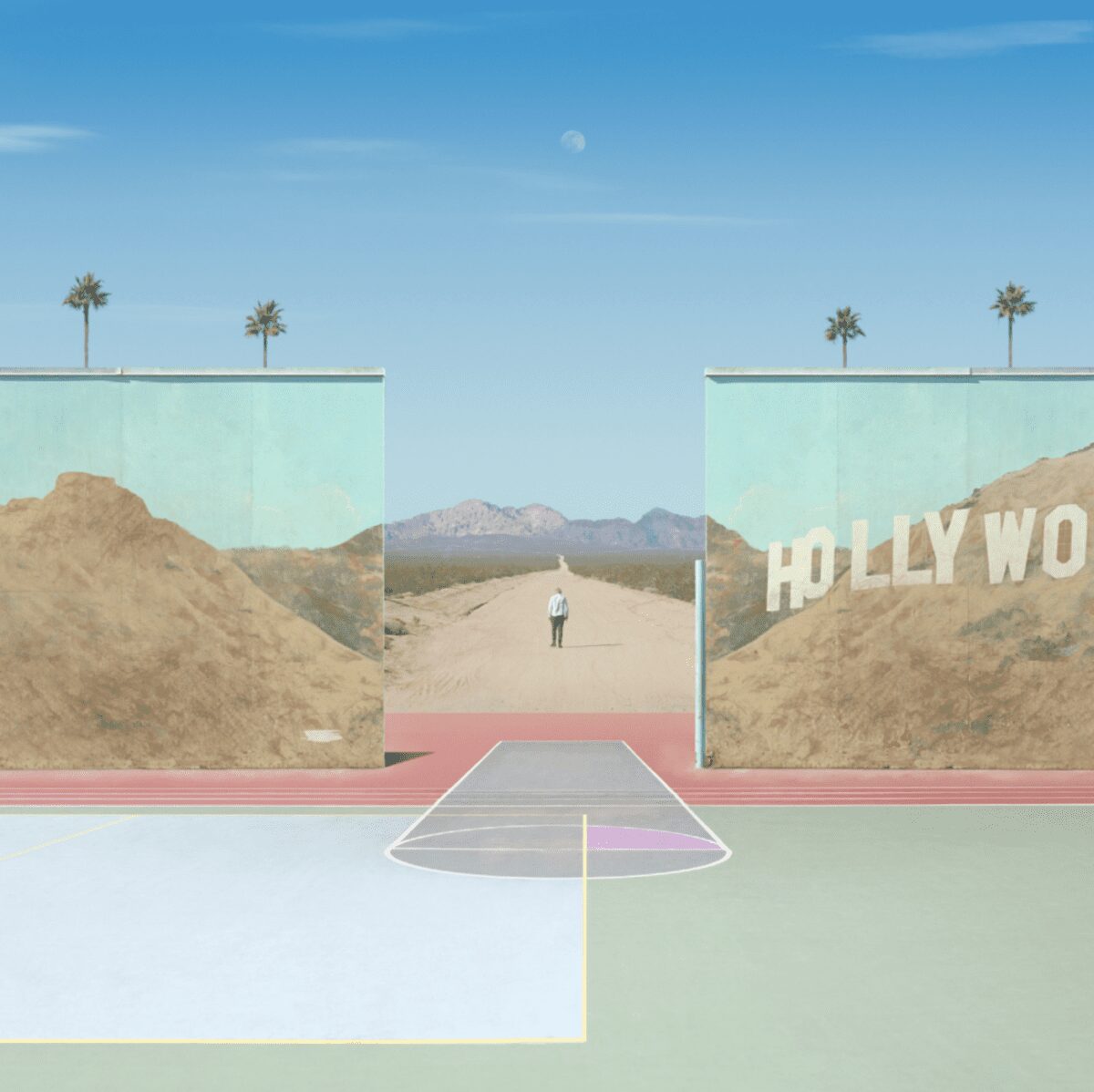

Archival Pigment Print
Photograph courtesy of George Byrne
From the series “Synthetica”
I want to return to several points you raised in responding to “Swan Song.” First is the presence of a person; in this case, your father is entirely symbolic. Is this the first time a family member has appeared in your work?
Yeah, I reckon that is the first time I’ve featured a family member in a picture for the exhibition! It just felt right on this occasion for that image.
How has your family informed your photographic practice?
I have a pretty big family: three sisters (two older and one younger, and my oldies just celebrated their 45th wedding anniversary!). To be honest, I’m not sure exactly how they’ve informed my practice – I’ve never been asked that!… I guess my parents had the biggest influence early by virtue of just getting behind all my creative interests growing up. Whatever I was passionate or curious about, they were passionate about helping me try and do it. But I was very supported by my whole family, and we’re a pretty tight unit even though we’re scattered all over the world.
On the topic of family- you are now a father. (Congratulations again!) What do you hope that your child feels when they look at your photographs years from now? Do you notice new elements of the landscape that you hadn’t previously paid attention to as a new parent?
I guess you just want your child to be proud of what you do and what you’ve done. It’s early days, but so far, since Chloe was born, I have felt very creatively inspired by her being here – even without sleep! I think when she’s old enough she’ll come to understand that I made all this work in LA because I was in love with the place, and that will be inspiring to her.
The absence of people from your work accentuates them in many ways. What characteristics do those who live in this synthetic world possess?
They’re often quite 2-dimensional and symbolic, almost sculptural. Usually alone. They could also be, in part, projections of myself, my own lived experience as an alien in a foreign land. But it’s more than that, it’s many things. Being an observational photographer is a pretty lonely business; to do it well, you have to be present but also invisible. You have to slide through space, and you have to be super focused and alert. When I’m out doing it, and I’m in the zone, I find it utterly exhausting.
Do you feel that you are at the end of this chapter of exploration? Is this potential ending a celebration of your relationship with Los Angeles?
Possibly, yes, it’s hard to know how one’s going to feel in a year or two, but right now, yes, I feel like the “Synthetica”series does have a feeling of closure or completion to it. I pushed a certain idea/process to what I felt was its limit, and I’d like to let it breathe. The truth is I have taken enough pictures already that I could have a show of new work every year for the rest of my life without ever picking up a camera. But it’s not just about that. The reason I fell in love with this work was I was driven by the magic of the city, I wasn’t driven for the outcome, I was just curious. I was trying to visually manifest something I was feeling in the environment. There are still many pictures I see here in LA that I’d love to take. Every time I go for a drive across the city, I see them, pictures that I should have caught, that I tell myself I’ll go back for, but I never do. Maybe I will revisit the series, but I can only comment on how I feel about it right now.
The elements of nature that thrive in your work are two different varieties of two distinctive types of trees- the Cypress and the Palm. My own fascination with the Palm tree has preoccupied most of my instant film project. I feel like they often go unnoticed as they are considered a ubiquitous part of the landscape rather than something extraordinary. This behavior prompted me to conduct preliminary research to discover the following: There are 2,500 different types of Palm trees, and yet there is only one palm species native to Southern California. The Washingtonia filifera, sometimes known as the “California Fan Palm.” The first known Palm recorded to have been planted in Southern California was the Serra Palm. Father Junipero Serra planted the tree in Old Town, San Diego, in 1769. What do you feel when you see a palm tree? What do they symbolize to you? Are they a totem for “Synthetica” as a link between each work?
I think a “totem” is a great way to put it. To me, the palm tree is the quintessential symbol of LA. They look good everywhere, they have so much character, they’re so tough and beautiful and hilarious, and they’ve been punctuating my photographs from the very start. They’re a bit like an organic firework, arrested at the point of explosion. You’ll find them in the poorest and wealthiest parts of LA equally, and everyone loves them. And having said all that, they’re not even native to LA, and the vast majority of them will be dead and gone in the next 50 years. Again, this is the perfect LA story: a transplant chasing a dream, only to crash and burn and make way for the next thing. What I would give to have been able to see the LA basin when the native Tongva and Chumash peoples roamed, pre-Spanish colonization. How beautiful and unrecognizable. In closing, LA is, in many ways, a city of synthesis, it’s a city of layers, all feeding and enriching.
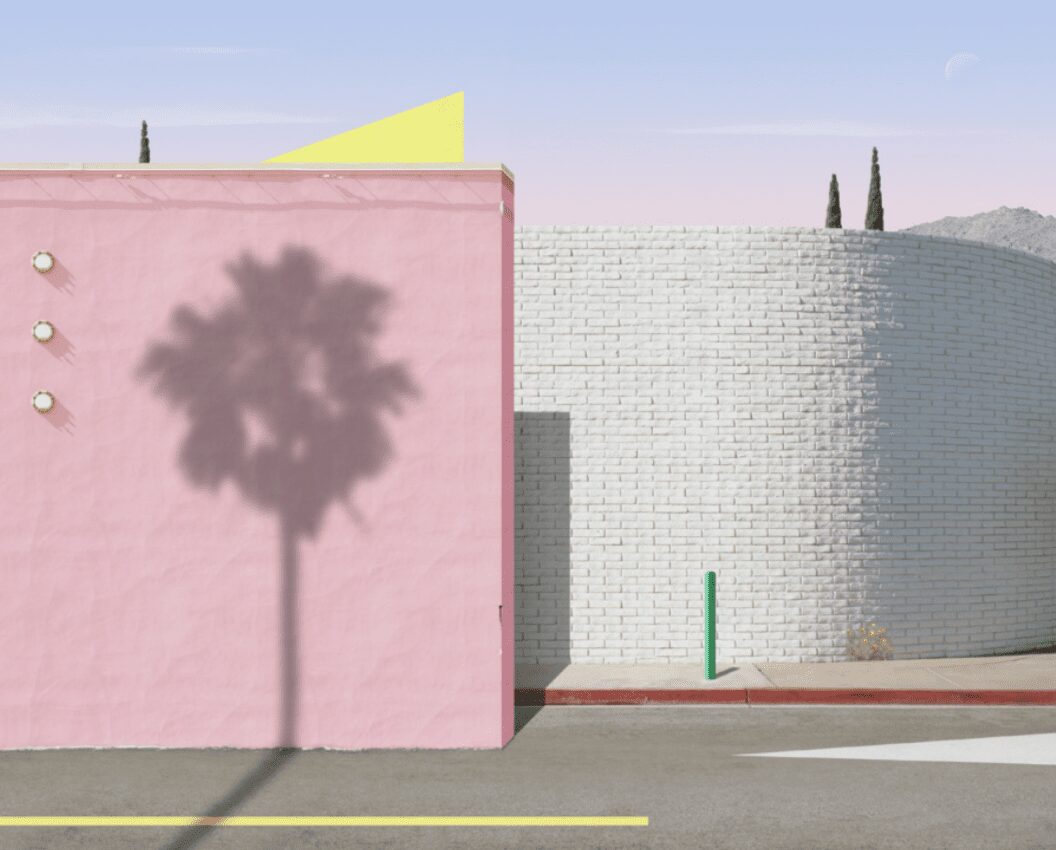

Archival Pigment Print
Photograph courtesy of George Byrne
From the series “Synthetica”



Archival Pigment Print
Image courtesy of George Byrne
From the series “Post Truth”
I love that phrase, “a transplant chasing a dream,” as it pertains not just to the Palm but to many others just like you who are not natively from Los Angeles but have established roots here. It also echoes a sentiment from Ernest Hemingway’s “A Moveable Feast,” a novel published posthumously that follows his journey as an expat living in Paris in the 1920s. He contends that you can’t write Paris when you’re in Paris. By “transplanting” yourself, he believes that “… in one place, you could write about it better than in another.” If you could speak with George Byrne ten years ago, first starting out in exploring LA and developing a style, what would you tell him?
I’d keep out of his way! I’d be worried I’d mess it up for him. Honestly, I wouldn’t change a thing about how my career in LA started and evolved. Those were some of the most thrilling years of my life. I could have spent more time hustling galleries and working the scene, but I’m hopeless at that. All my breaks have come from working really hard and people coming to me because they like my work and want to collaborate. That’s the model that has worked for me, and I wouldn’t have it any other way.
At first glance, the photographs present manicured moments made spectacular by pristine pastel tones. Compressed two-dimensional compositions simultaneously present architecture that resists historic landmark status yet looks familiar because we’ve encountered something like it on our way somewhere. Can you feel an undeniable sense of déjà vu for a place you’ve never been?
The world of George Byrne’s “dreamscapes” in his latest body of work aptly titled “Synthetica” taps into a collective consciousness of the urban, the quotidian, and the surreal. His decade-long love for his muse and the city he adopted as his home, Los Angeles, has made his photographs unofficial topographic records. The artist revels in a landscape built upon the illusion of Hollywood as he stitches together layers of imagery captured over the years like a mound of film strips spliced and presumed lost on the editing room floor. The director has called out “cut,” the backdrop has now split into two, revealing the San Bernardino mountains, which align perfectly with the trompe l’oeil set in the foreground. The question should be other than where the artifice ends and reality begins, and instead, consider how they can co-exist in the same scene. Just as the man in “Swan Song” stands at the precipice of where the playground ends and an unpaved path due north begins, we have traveled the roads of Los Angeles through the synthetic opus of George Byrne.
George Byrne’s solo exhibition “Synthetica” opens Thursday, June 13, 2024 and will be on view through July 14, 2024 by appointment
The exhibition is curated by Margot Ross at Show Gallery located at 1515 N. Gardner Street Los Angeles, CA, 90046
Featured Image: George Byrne, “Rego Sport Tuning” 2024
Archival Pigment Print
Photograph courtesy of George Byrne
From the series “Synthetica”
